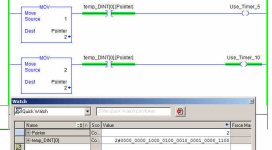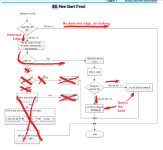AutomationTechBrian
Lifetime Supporting Member
So, AutomationTechBrian only wants to shift 5 bits of a DINT, leaving the remaining bits unchanged.
Well... at the point you start to recognize me, you can trim that down to just "Brian."
I think I'm going to just use BSR, then use the value of the array as a condition to cycle through another cycle: BitArray does not equal 0. Also, if the only values of the array are in the first two stations, the 5 minute timer can be used, versus the 15 minute timer for any other condition.
Beyond that, I've never used BTD for anything, so I'm looking forward to checking that out. But first, I realized that this would be the perfect project to get familiar with using SFC for the cycle routine of lifting the product up, moving over to the next bin, then returning to the home position. I've only programmed in ladder and FB, with a little ST for setting some values. Again, just like BSL and BSR, I've been waiting for something like this to get familiar with SFC.
My internet is still limited until tomorrow afternoon. Some of the videos I've wanted to check out are too difficult to follow on my phone. ...It's hard to see the values on the screen.





